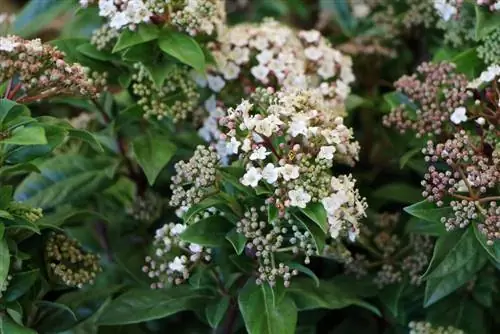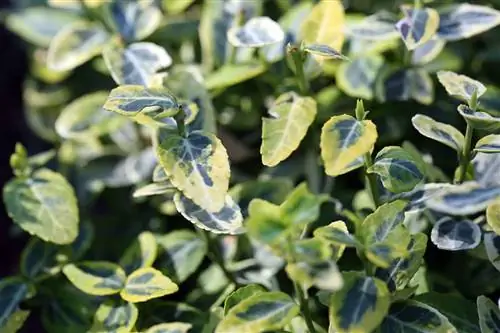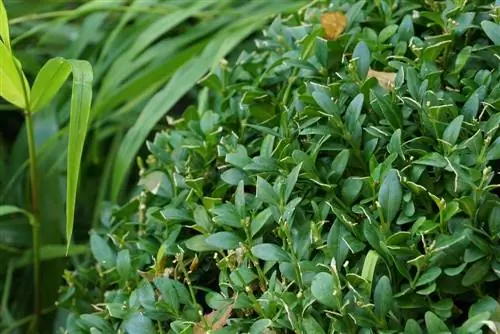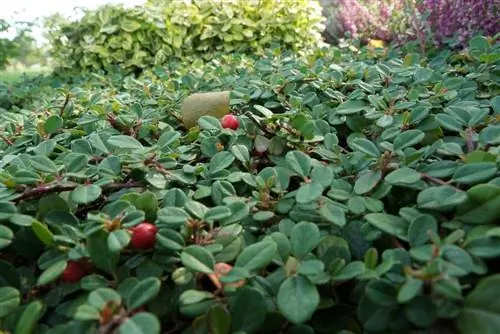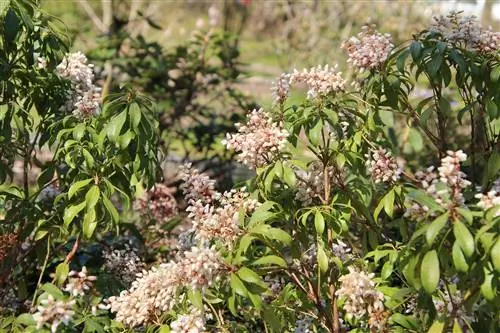- Author admin [email protected].
- Public 2023-12-17 03:39.
- Last modified 2025-01-24 12:45.
This guide introduces 12 worthwhile evergreen trees and shrubs. Since they are native, they are well adapted to the local climatic conditions. Many are also suitable as privacy hedges.
Fat Man
- Botanical name: Pachysandra terminalis
- maximum height: 20 cm to 30 cm
- Flowering period: April to May
- Flower color: white
- Fruit decorations: no
- Location: partial shade to shade
- Soil requirements: fresh and moist, permeable, acidic to semi-acid
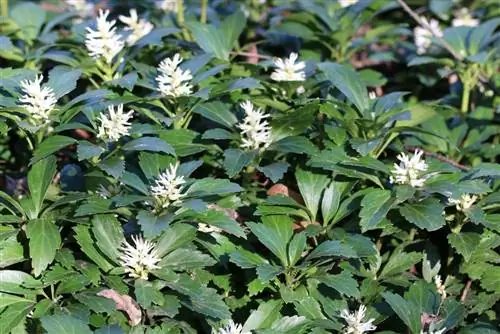
The fat man is one of the most popular ground cover plants in German gardens. Although it actually comes fromJapan and China, it is almost considered native due to its frequent use. In this country it has many synonyms such as Japanese ysander, thick anther or shadow green. The latter name refers to the advantage that the fat man provides color in dark garden corners all year round. Even sun generally does not harm the ground cover. However, in bright locations the plant loses its rich green foliage and turns light yellow. The undemanding nature and easy care also contribute to the great popularity of this small tree.
Note:
In order to prevent the fat man from forming a dense, overgrown carpet after a short time, pruning is urgently necessary.
Firethorn 'Red Column'
- Botanical name: Pyracantha coccinea 'Red Column'
- Maximum height: 1.5 m to 2.5 m
- Flowering period: May to June
- Flower color: white
- Fruit decoration: pea-sized, berry-shaped stone fruits in bright red
- Location: Sun to partial shade
- Soil requirements: normal garden soil, permeable
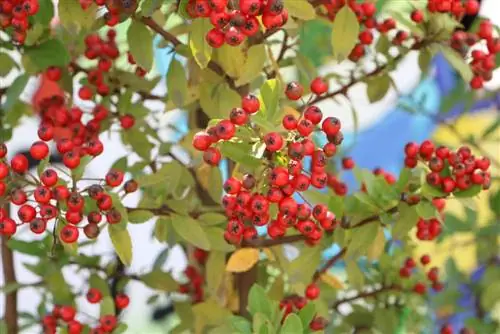
The variety 'Red Column' is considered to be the fastest-growing of its kind. This makes it ideal for a garden hedge. With an average height of 2 m (sometimes up to 4 m), the gardener feels protected from intrusive glances, but does not feel cramped in his own garden. The bright red leaves, which are also complemented by small berry-like stone fruits, are a real eye-catcher that makes a firethorn hedge unique in the neighborhood. These shrubs do not require any extensive care, even though they actually come from southeastern Europe and the Caucasus region, they also feel at home here. Light frost protection is only recommended for late frosts and dry summers.
Note:
The optimal planting distance when used as a hedge is 30 to 40 cm.
Evergreen Snowball
- Botanical name: Viburnum Pragenese
- maximum height: 2 to 4 m
- Flowering period: May to June:
- Flower color: white
- Fruit decorations: no
- Location: Sun to partial shade
- Soil requirements: permeable, nutrient-rich, humus and fresh
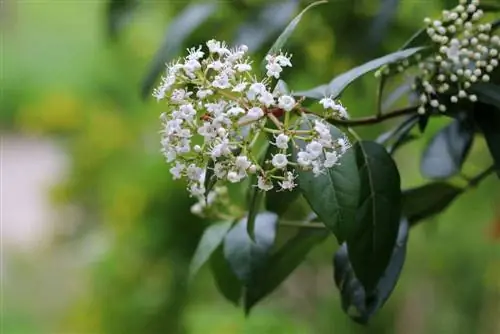
The evergreen snowball lives up to its name. Although the creamy white, intensely fragrant flowers only appear in early summer, the plant is evergreen even in winter. This specimen is also very easy to care for. The upright, slightly branched growth of the dark green, shiny leaves generally does not require pruning. However, Viburnum Pragenese is happy about regular watering with old water during the cold season.
Cushion Barberry
- Botanical name: Berberis buxifolia
- maximum height: 60 cm to 80 cm
- Flowering period: May to June
- Flower color: orange, yellow
- Fruit decorations: no
- Location: Sun to partial shade
- Soil requirements: all soils
The upholstery barberry is wonderfully undemanding. It is suitable for greening graves and rock gardens, but also serves as a hedge. In this case, the bushes grow so close together that they form an impenetrable barrier even for cats.
Portuguese laurel cherry
- Botanical name: Prunus lusitanica
- maximum height: 6 to 8 m
- Flowering time: June
- Flower color: white
- Fruit decoration: black to purple berries
- Location: Sun to partial shade
- Soil requirements: normal garden soil, nutrient-rich, permeable, slightly moist without waterlogging
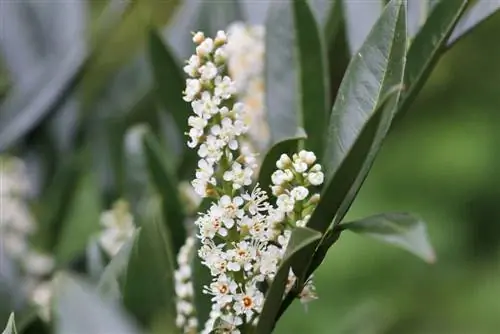
The Portuguese laurel cherry is closely related to the cherry laurel, but due to its impressive appearance it is a very special eye-catcher in German gardens. Since the Portuguese laurel cherry (as the name suggests) comes from the Mediterranean region, it should only be grown in really warm and mild regions. With its white flowers, which stand in interesting contrast to the dark green, shiny foliage, it has a more Mediterranean charm. Its growth is dense and compact and, when pruned sparingly, develops an attractive crown. The Portuguese laurel cherry is particularly popular as a hedge plant because it grows into an opaque tree in a very short time. But the native shrub is also suitable for the pot on the terrace. What is particularly noticeable here is its intense scent of honey.
Red medlar ‘Red Robin’
- Botanical name: Photinia fraseri 'Red Robin'
- Maximum height: 1.5 m to 3 m
- Flowering period: May to June
- Flower color: white
- Fruit decoration: red balls
- Location: sun or shade
- Soil requirements: warm, lime-free, slightly loamy, humic, deep

What a sight when the bright white flowers of the red loquat appear in front of the deep red foliage in early summer. Only later in the year do the leaves take on a copper-green color. Although this plant is native and therefore adapted to the local climate, the gardener must pay greater attention to choosing the right location. Under no circumstances should the medlar be left in a cold, windy place. Unfortunately, despite meeting these requirements, it is only partially hardy.
Columns Bergilex
- Botanical name: Ilex crenata 'Fastigiata'
- maximum height: 20 cm to 25 cm
- Flowering period: May to June
- Flower color: white
- Fruit decorations: ball fruits
- Location: Sun to partial shade
- Soil requirements: acidic to neutral (pH value 5 or 6), humic, nutrient-rich, sufficiently moist
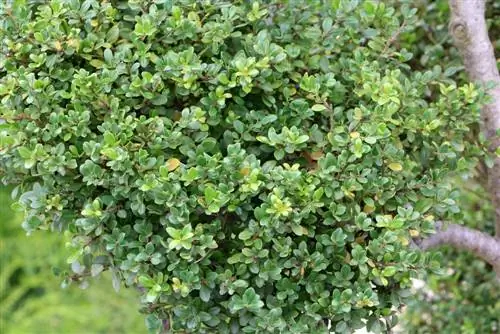
The leaves of this impressive tree are visually reminiscent of a boxwood. But the Bergilex columns have nothing in common with the spherical growth of this plant. It grows in an attractive, narrow pyramidal shape. For this very reason it is the ideal planting partner for spherically growing native plants. Since the growth habit goes well with a bonsai, the Bergilex is mainly used in gardens that are designed according to the Japanese model. Individual branches can also be tied into wreaths just as easily.
Shadow Bells 'Little Heath'
- Botanical name: Pieris japonica 'Little Heath'
- maximum height: 50 cm to 60 cm
- Flowering time: end of March to May
- Flower color: white
- Fruit decorations: no
- Location: Sun to partial shade
- Soil requirements: fresh and moist, humic, permeable, slightly acidic to acidic
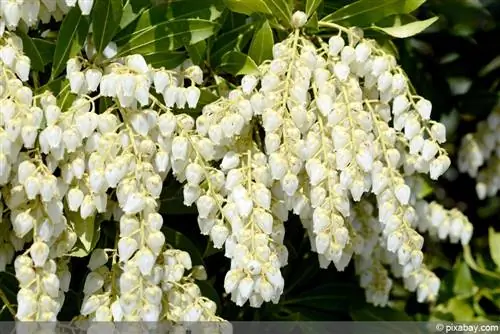
This dwarf shrub is particularly impressive at the beginning of the year when its new leaves sprout. At this time they are bright red in color. The color later regulates to a matt green-white. Sometimes the foliage is slightly pink.
Narrow-leaved cherry laurel
- Botanical name: Prunus laurocerasus
- maximum height: up to 3 m
- Flowering time: May
- Flower color: white
- Fruit decoration: black, spherical berries (poisonous)
- Location: sunny to partially shaded
- Soil requirements: sandy, humus
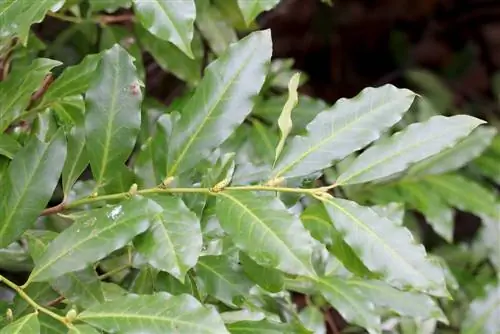
Depending on the variety, the narrow-leaved cherry laurel is ideal as a hedge plant. Slender, upright growing species are particularly recommended for this purpose. And the tree is definitely not lacking in species diversity. However, all varieties have the attractive, leathery leaves in common. It is definitely worth letting Prunus laurocerasus grow, as frequent pruning inhibits flower and fruit formation.
Note:
Prunus laurocerasus is also suitable for keeping in containers.
Holly 'Hedge Fairy'
- Botanical name: Ilex meserveae
- maximum height: 60 cm to 1.5 m
- Flowering period: May to June
- Flower color: green-white, rather inconspicuous
- Fruit decoration: bright red berries
- Location: Sun to partial shade
- Soil requirements: nutrient-rich
Whether as a solitary plant or in the hedge - the holly is an eye-catcher in every respect. The dark green foliage gains even more visual charm through the appearance of the bright red berries. The shrubs are also considered to be very robust and extremely hardy. Ideal planting partners are
- Ivy
- Buchs
- Mahony
- Cherry Laurel
- Yew
Note:
In order for the red berries to appear every year, the holly 'Heckenfee' needs a male pollinator. The variety 'Heckenstar' comes in very handy both in terms of name and practicality.
Shrub Ivy 'Arborescens'
- Botanical name: Hedera helix 'Arborescens'
- maximum height: 1.5 m
- Flowering time: August and September
- Flower color: greenish yellow
- Fruit decorations: no
- Location: partially shaded to shady
- Soil requirements: nutrient-rich, not too dry
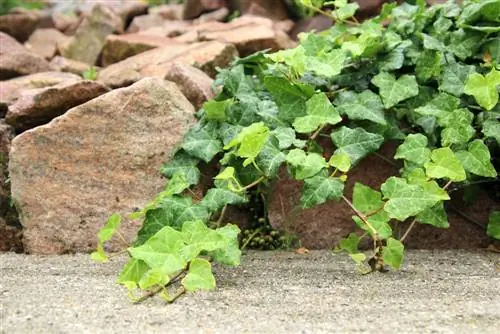
This type of ivy is the ideal greenery for shady, narrow gardens. Even without any sunlight, it develops evergreen foliage. It also blooms relatively late in the year, making it an important source of nectar for insects before hibernation. This shrub has little in common with the well-known, climbing ivy. As a creeping plant, it is more suitable for greening dark beds.
Cotoneaster
- Botanical name: Euonymus
- maximum height: 30 cm to 50 cm
- Flowering time: June and July
- Flower color: inconspicuous
- Fruit decorations: no
- Location: sun or shade
- Soil requirements: normal garden soil
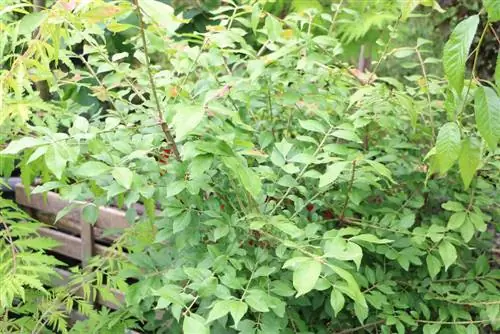
In contrast to other trees, the white-colored cotoneaster impresses less with its flowers than with its colorful foliage. The small, native shrub has pink, white and green foliage all year round. At the beginning of autumn the leaves even turn slightly reddish. Small gardens in particular benefit from the very low growth height. This makes the cotoneaster unusable as a privacy screen, but as a ground cover its color display is a worthwhile addition to any garden bed.
Note:
The white-colored cotoneaster is also content with a shady location. However, the beautiful foliage color comes into its own more intensively in sunny places.

